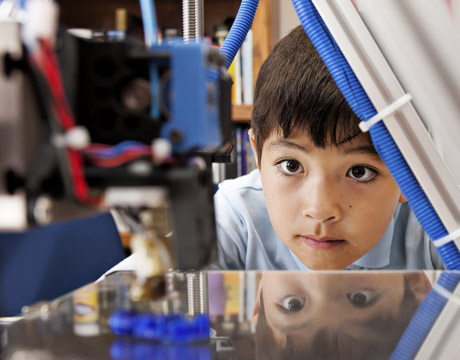3D Printing Engages Students in STEM
3D Printing Engages Students in STEM


As the STEM initiative for education continues, nowhere is it more important than at the elementary school level. But teachers need creative ways to engage what can be a tough crowd. A big help in that regard would be 3D printing, but it has been a barrier, particularly because of price.
Still, slowly, its impact is being seen.
Through a grant, Markus Hartnett, who teaches fourth and fifth graders, was able to have a 3D printer to share with over 200 students at Glen Grove School in Glenview, IL. “We have been heavily immersed in the concept of building a prototype, revising it, testing it, building, and growing,” he says. “They gather feedback from fellow students and get back into it.”
Hartnett, who was previously part of a Chicago Tribune article on the school’s 3D printing experience, recalls the students’ mission. They were to colonize a new planet, in which each student “received a message from one of the people from that planet” about a particular problem. “Students would come up with a design and they took a clay design and put it into 3D software,” he says. “For them to see their thoughts put into action, the expressions on their faces were incredible.”
In the end, they were able to print roughly twenty designs.
One standout design was the result of a planetary problem in which there were not enough nutrients in the food. “One student built a product in the shape of a stapler and it would squirt nutrients into the food. Or, there was another problem where the solution was a slingshot for sending garbage up in the air with the idea of them burning like fireworks. They have great imaginations.”
The results have been very positive. “I think 3D printing is a great tool to ease the fear of failure,” he says. “A student can design a prototype and see how it works and, if it fails, they can modify their design and print another one. Even engineers at the professional level have to deal with failure and adjustment. Also, if we can get them comfortable with 3D printers now, if that’s just the nature of their experience growing up, then they will expect to use it later in life and be comfortable with it.”
Yolanda Valencia, the science and engineering chair at Gulliver Academy in the Miami area, has worked on 3D printing with third and fourth graders after school and has also found it beneficial. “Introducing it to the kids, 3D printing was very intuitive for them,” she says. “They were printing little houses, printed things for Minecraft. They loved it.” They were even asked to print out what they think an astronaut could use in space.
But more than just having fun, she absolutely believes it ups their chances of choosing a career in the STEM field. “It takes something that’s an unknown and makes it comfortable and exciting,” she says. “The looks on their faces, you can’t believe what a 3D printer does to them.”
Eric Butterman is an independent writer.
Learn more about the latest technologies in 3D printing at ASME’sAM3D 2015.
I think 3D printing is a great tool to ease the fear of failure. A student can design a prototype and see how it works and, if it fails, they can modify their design and print another one. Markus Hartnett, teacher, Grove School



